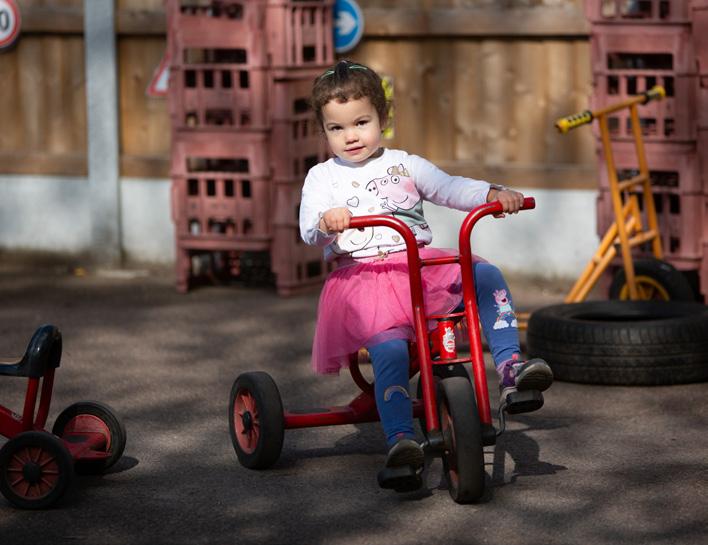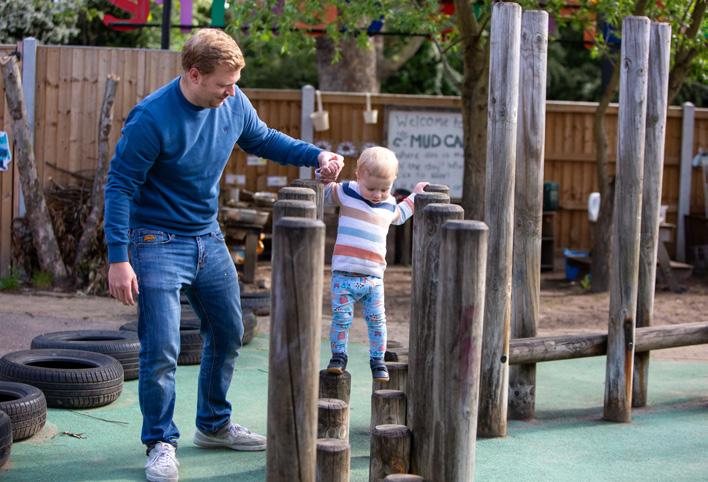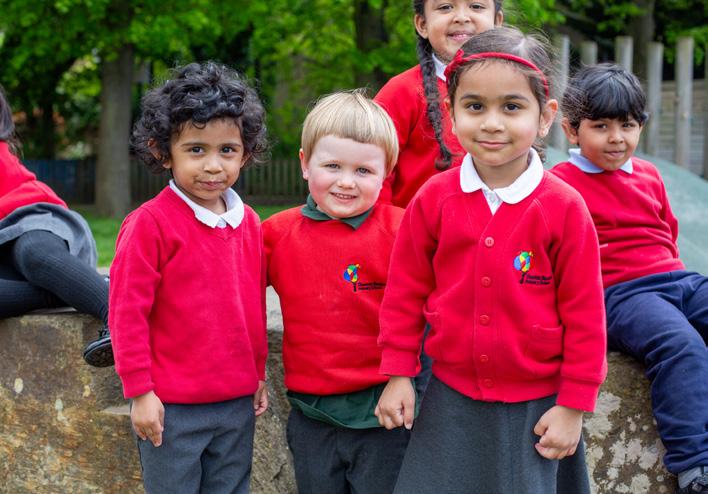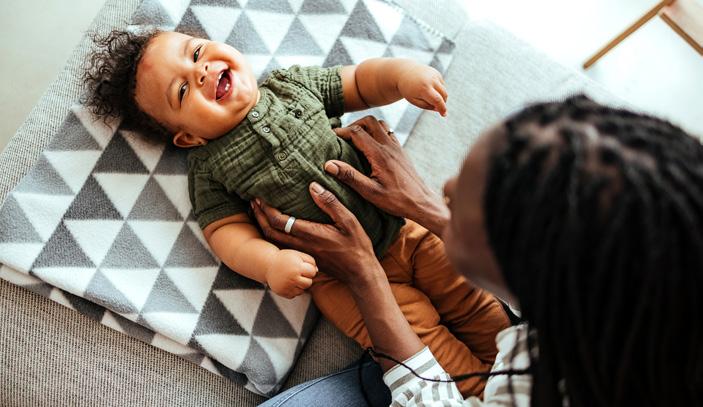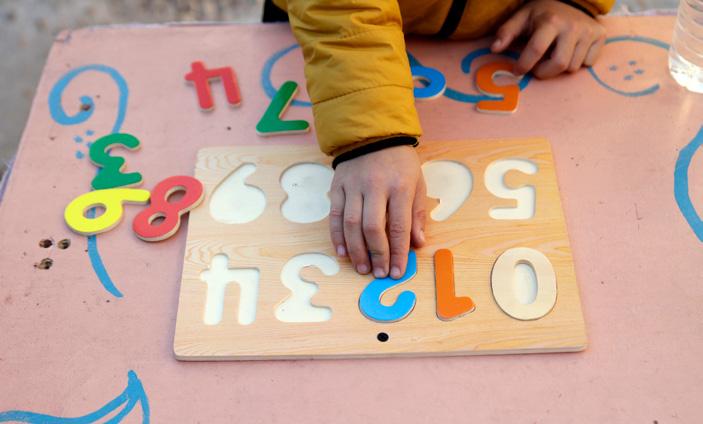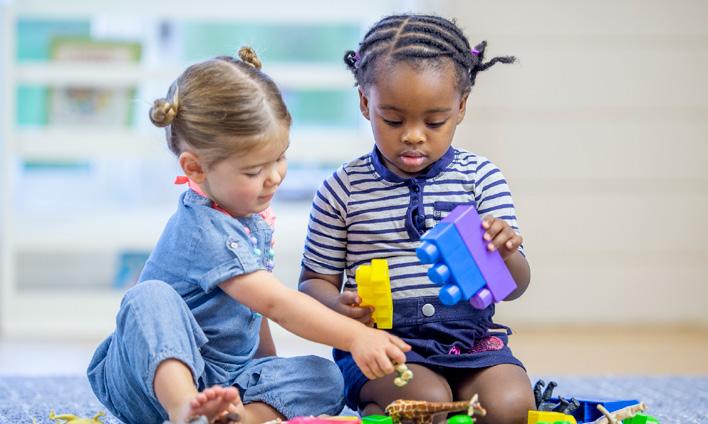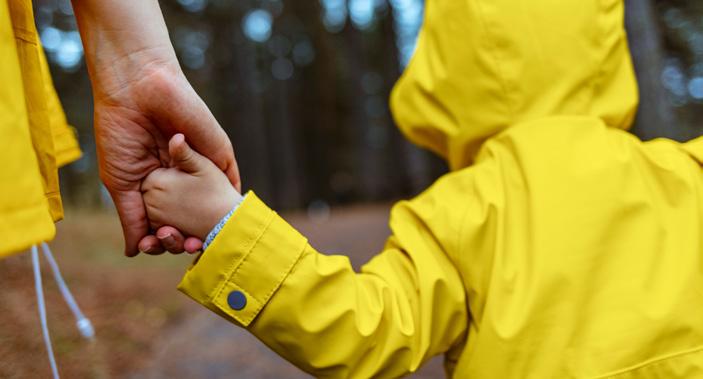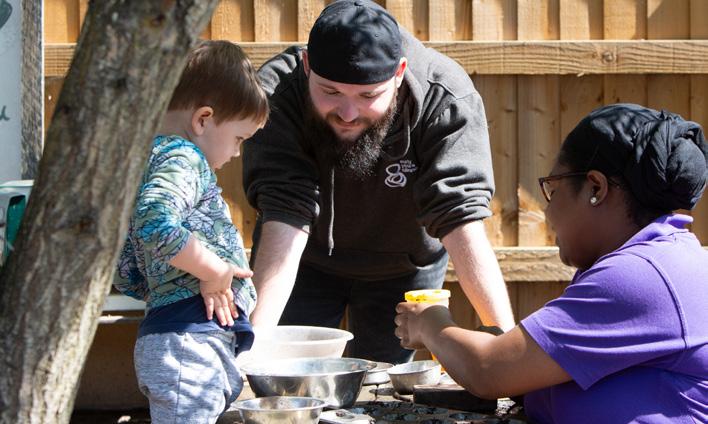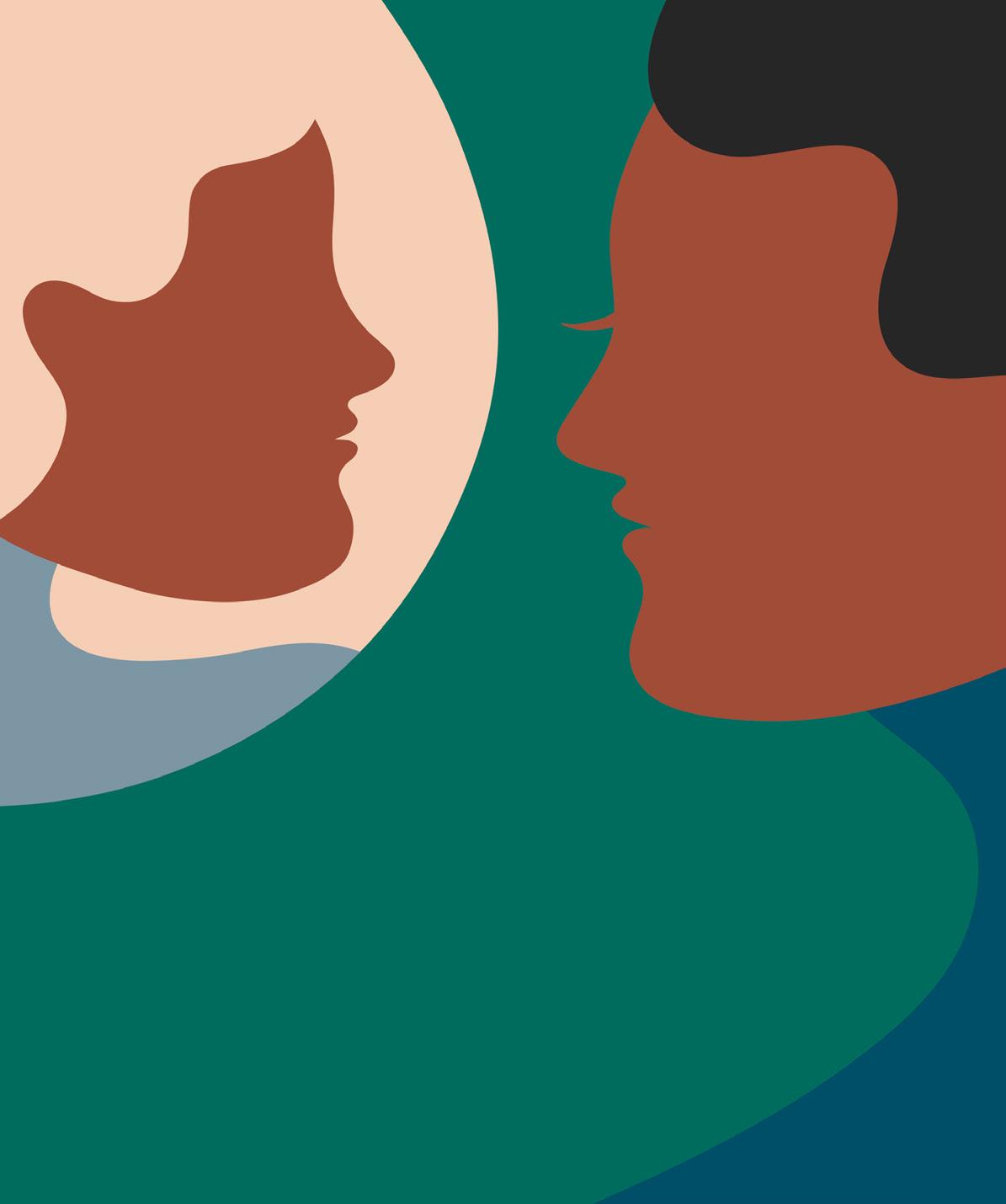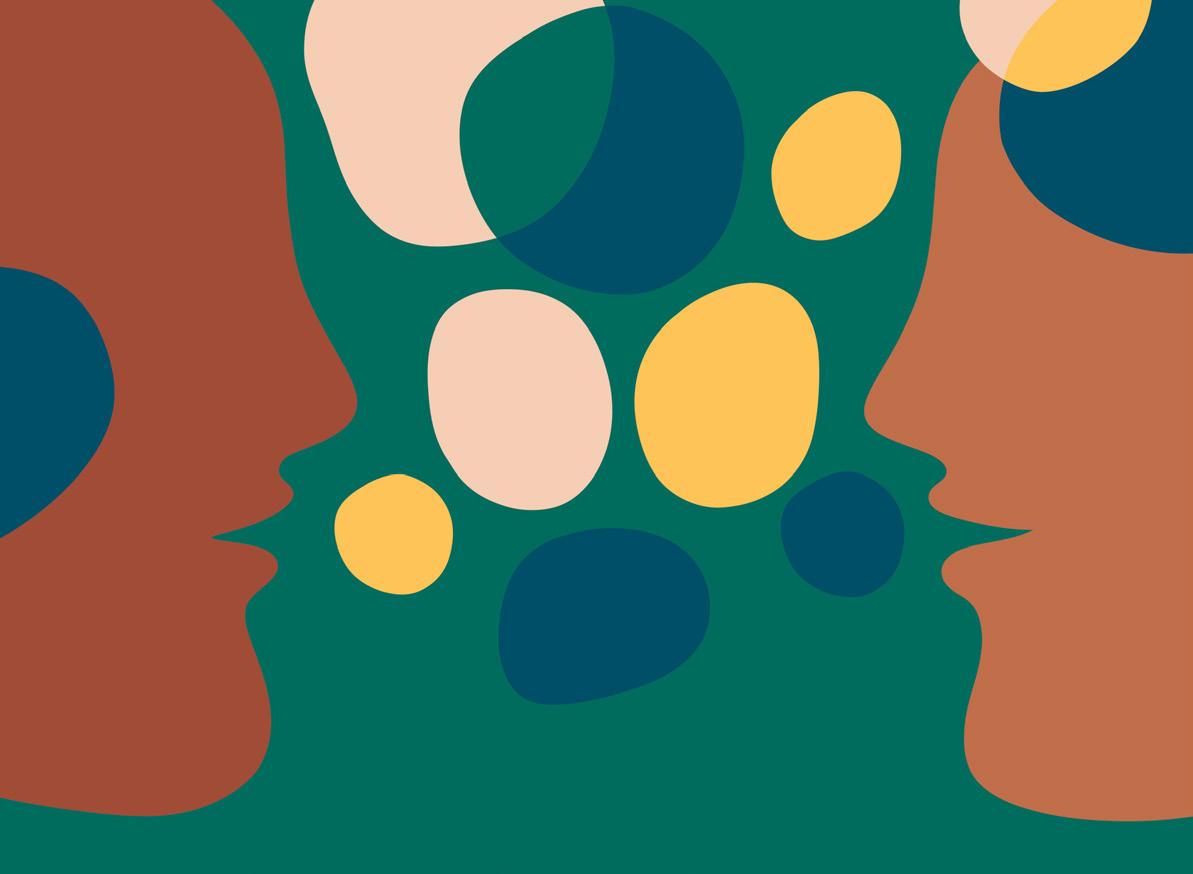Feel joy
Take a moment to consider what brings you joy – maybe it is reuniting with a loved one, achieving a goal you have worked hard towards, or simply listening to your favourite piece of music. Although what brings each of us joy is very individual, joy is learned through social experiences and is one of most recognisable emotions across cultures (Izard, 1971; Ekman, 1992; Watkins, 2020; Arnett, 2023; Rogoff, 2003). Definitions of joy vary but tend to centre around a temporary emotional state that involves feeling elated or ecstatic. Joy can be caused by an alignment between one’s lived experience and one’s desired experience or a connection to something bigger than oneself (Emmons, 2020; Matthews, 2020; Arnett, 2023).
Although joy cannot be produced voluntarily, one can promote the capacity for joy by creating an environment which provides opportunities to experience the emotion ( Izard, 1972; 1977). While joy can be experienced alone, it is most frequently experienced with others (Johnson, 2020), and in children it is often associated with play. As such, developing a capacity for joy might include a caregiver fostering a close-relationship with a child and supporting them to play, or playing with them.
Related to the wealth of literature on the importance of play, joy has been found to support one’s willingness to play (Friedrisckson, 2004), ability to cope with challenges, and capacity to enjoy one’s life (Izard, 1977; Tornare et al., 2017). Experiencing joy in social events has also been found to promote wellbeing and strengthen a sense of community (Gabriel et al., 2020). While joy is a distinct emotion, early positive mood - which includes joy - has been found to uniquely predict life satisfaction in adulthood (Coffey et al., 2014: Lyubomirsky et al., 2005).
6. References
Adachi, P. J., & Willoughby, T. (2013). More than just fun and games: the longitudinal relationships between strategic video games, self-reported problem solving skills, and academic grades. Journal of Youth and Adolescence, 42, 1041-1052.
Aldao, A., Sheppes, G., & Gross, J. J. (2015). Emotion Regulation Flexibility. Cognitive Therapy and Research, 39, 263-278.
Ainsworth, M.D., & Bowlby, J. (1991). An Ethological Approach to Personality Development. American Psychologist, 46, 333-341.
Aknin, L.B., Van de Vondervoort, J.W., & Hamlin, J.K. (2018). Positive feelings reward and promote prosocial behavior. Current Opinion in Psychology, 20, 55–59.
Allen, S. (2018). The Science of Generosity. UC Berkley Greater Good Science Center.
Appadurai, A., 2004, The Capacity to Aspire: Culture and the Terms of Recognition. In V. Rao & M. Walton (Eds.) Culture and Public Action (pp.59-84). Stanford University Press.
Arnett, J. J. (2023). Joy: An integrative theory. The Journal of Positive Psychology, 18(1), 1-14.
Ashinoff, B.K., & Abu-Akel, A. (2021). Hyperfocus: the forgotten frontier of attention. Psychological Research, 85(1), 1-19.
Bailey, R., & Jones, S. M. (2019). An integrated model of regulation for applied settings. Clinical Child and Family Psychology Review, 22, 2-23.
Bailin, S. (2002). Critical thinking and science education. Science & Education, 11(4), 361–375.
Baillergeau, E., & Duyvendak, J. W. (2022). Dreamless futures: A micro-sociological framework for studying how aspirations develop and wither. Critical Studies in Education, 63(2), 196-211.
Bandura, A. (2012). On the Functional Properties of Perceived SelfEfficacy Revisited. Journal of Management, 38(1), 9–44.
Baron-Cohen, S. (2022). The Pattern Seekers. Penguin.
Barton, K. & McCully, A. (2007). Teaching controversial issues where controversial issues really matter. Teaching History, 127, 13-19.
Bateman, A., Constantinou, M. P., Fonagy, P., & Holzer, S. (2021).
Eight-year prospective follow-up of mentalization-based treatment versus structured clinical management for people with borderline personality disorder. Personality Disorders: Theory, Research, and Treatment, 12(4), 291.
Bednarski, F., Mushold, K., & Grosse Weissmann, C. (2022). Do infants have agency? – The importance of control for the study of early agency. Developmental Review, 64, 101022.
Bennett, D. S., Bendersky, M., & Lewis, M. (2005). Antecedents of emotion knowledge: Predictors of individual differences in young children. Cognition & emotion, 19(3), 375-396.
Bertilsdotter Rosqvist, H., Hultman, L., & Hallqvist, J. (2023). Knowing and accepting oneself: Exploring possibilities of self-awareness among working autistic young adults. Autism, 27(5), 1417-1425.
Best, J. R., & Miller, P. H. (2010). A developmental perspective on executive function. Child Development, 81(6), 1641–1660.
Beuker, K.T., Rommelse, N.N.J., Donders, R., & Buitelaar, J.K. (2013). Development of early communication skills in the first two years of life. Infant Behaviour and Development, 36(1), 71-83.
Beyth-Marmom, R., Novik, R., & Sloan, M. (1987). Enhancing children’s thinking skills: an instructional model for decision-making under certainty. Instructional Science, 16(3), 215–231.
Bond, F.W., Lloyd, J., Flaxman, P.E. & Archer, R. (2011). Psychological flexibility and ACT in the workplace: Impacts on performance and mental health. Journal of Occupational Health Psychology, 16(2), 238-255.
Bowlby, J. (1988). A secure base: Parent-child attachment and healthy human development. Basic Books.
Bronwell, J. (2018). Listening. Attitudes, principles and skills (6th Ed.). Pearson Education.
Brown, A. L., & Kane, M. J. (1988). Preschool children can learn to transfer: Learning to learn and learning from example. Cognitive Psychology, 20(4), 493-523.
Bruine de Bruin, W., & Parker, A. M. (2016). Individual differences in decision-making competence in different age groups. In Toplak, M. E., & Weller, J. (Eds.). Individual differences in judgement and decisionmaking: A developmental perspective (pp.127-146). Psychology Press.
Brushe, M.E., Haag, D.G., Melhuish, E.C., Reilly, S., & Gregory, T. (2024). Screen Time and Parent-Child Talk When Children Are Aged 12 to 36 Months. Journal of the American Medical Association Pediatrics, 178(4), 369-375.
Buckley, B. (2003). Children’s Communication Skills: From Birth to Five Years. Routledge.
Buttelmann, F., & Karbach, J. (2017). Development and Plasticity of Cognitive Flexibility in Early and Middle Childhood. Frontiers in Psychology, 8, 1040.
Byrnes J. P. (2002). The development of decision-making. The Journal of adolescent health: official publication of the Society for Adolescent Medicine, 31(6 Suppl), 208–215.
Cage, E., & Troxell-Whitman, Z. (2019). Understanding the Reasons, Contexts and Costs of Camouflaging for Autistic Adults. Journal of Autism and Developmental Disorders, 49(5), 1899-1911.
Cameron, J. (2022). “What’s love got to do with it?” Bringing love into international development research. Canadian Journal of Development Studies/Revue canadienne d’études du développement, 43(3), 439-456.
Canter, D., Youngs, D., & Yaneva, M. (2017). Towards a measure of kindness: An exploration of a neglected interpersonal trait. Personality and Individual Differences, 106, 15-20.
CASEL: Collaborative for Academic, Social, and Emotional Learning. (2020). CASEL’s SEL framework: What are the core competence areas and where are they promoted? Collaborative for Academic, Social, and Emotional Learning (CASEL). Available from: https://casel.org/casel-selframework-11-2020/. Accessed [17/10/24].
Carranza, F. D., You, S., Chhuon, V., & Hudley, C. (2009). Mexican American adolescents’ academic achievement and aspirations: The role of perceived parental educational involvement, acculturation, and self-esteem. Adolescence, 44(174), 313–333.
Caspi, A. (2011), ‘A gradient of childhood self-control predicts health, wealth, and public safety’, Proceedings of the National Academy of Sciences, 108(7), 2693–8.
Cavadini, T., Richard, S., Dalla-Libera, N., & Gentaz, E. (2021). Emotion knowledge, social behaviour and locomotor activity predict the mathematic performance in 706 preschool children. Scientific Reports, 11(1), 14399.
Center on the Developing Child at Harvard University (2011). Building the Brain’s “Air Traffic Control” System: How Early Experiences Shape the Development of Executive Function: Working Paper No. 11. Available from: http://www.developing child.harvard.edu [Accessed 14/11/24].
Centre for Early Childhood (2021). Big Change Starts Small. Available from: https://centreforearlychildhood.org/report/. [Accessed 10/06/24].
Cipriano, C., Strambler, M.J., Naples, L.H., Ha, C., Kirk, M., Wood, M., Sehgal, K., Zieher, A.K., Eveleigh, A., McCarthy, M., Funaro, M., Ponnock, A., Chow, J.C., & Durlak, J. (2023). The state of evidence for social and emotional learning: A contemporary meta-analysis of universal schoolbased SEL interventions. Child Development, 94(5), 1181-1204.
Coffey, J. K., Warren, M. T., & Gottfried, A. W. (2015). Does infant happiness forecast adult life satisfaction? Examining subjective wellbeing in the first quarter century of life. Journal of Happiness Studies, 16, 1401-1421.
Credé, M., Tynan, M. C., & Harms, P. D. (2017). Much ado about grit: A meta-analytic synthesis of the grit literature. Journal of Personality and Social Psychology, 113(3), 492–511.
Cropley, A. J. (1972). A five-year longitudinal study of the validity of creativity tests. Developmental Psychology, 6(1), 119–124.
Daros, A. R., Haefner, S. A., Asadi, S., Kazi, S., Rodak, T., & Quilty, L. C. (2021). A meta-analysis of emotional regulation outcomes in psychological interventions for youth with depression and anxiety. Nature Human Behaviour, 5(10), 1443-1457.
D’Cruz, A. M., Ragozzino, M. E., Mosconi, M. W., Shrestha, S., Cook, E. H., & Sweeney, J. A. (2013). Reduced behavioral flexibility in autism spectrum disorders. Neuropsychology, 27(2), 152-160.
DeCasper, A. J., & Fifer, W. P. (1980). Of human bonding: Newborns prefer their mothers’ voices. Science, 208(4448), 1174-1176.
Decety, J. (2007). Perspective Taking as the Royal Avenue to Empathy. In B. F. Malle & S. D. Hodges. Other Minds: How Humans Bridge the Divide Between Self and Others (pp.143-175). Guildford Press.
De Jesus, S. N., Rus, C. L., Lens, W., & Imaginario, S. (2013). Intrinsic motivation and creativity related to product: A meta-analysis of the studies published between 1990–2010. Creativity Research Journal, 25(1), 80–84.
Delgado, H., Lipina, S., Pastor, M. C., Muniz-Terrera, G., Menéndez, Ñ., Rodríguez, R., & Carboni, A. (2024). Differential psychophysiological responses associated with decision-making in children from different socioeconomic backgrounds. Child Development, 10.1111/cdev.14082. Advance online publication.
Denckla, C.A., Cicchetti, D., Kubzansky, L.D., Seedat, S., Teicher, D.R., & Koenen, K.C. (2020). Psychological resilience: an update on definitions, a critical appraisal, and research recommendations. European Journal of Psychotraumatology, 11(1), 1822064.
Denham, S. A. (2019). Emotional competence during childhood and adolescence. In V. LoBue, K. Pérez-Edgar & K. A. Buss (Eds.), Handbook of emotional development (pp. 493–541). Springer Nature Switzerland AG.
Denham, S. A., Bassett, H. H., Brown, C., Way, E., & Steed, J. (2015). “I Know How You Feel”: Preschoolers’ emotion knowledge contributes to early school success. Journal of Early Childhood Research, 13(3), 252-262.
Denham, S. A., Ferrier, D. E., Howarth, G. Z., Herndon, K. J., & Bassett, H. H. (2016). Key considerations in assessing young children’s emotional competence. Cambridge Journal of Education, 46(3), 299–317.
Denham, S. A., Zoller, D., & Couchoud, E. A. (1994). Socialization of preschoolers’ emotion understanding. Developmental psychology, 30(6), 928.
Derryberry, D., & Reed, M. A. (2002). Anxiety-related attentional biases and their regulation by attentional control. Journal of Abnormal Psychology, 111(2), 225–236.
Deutsch, M., Coleman, P. T., & Marcus, E. C. (Eds.). (2011). The handbook of conflict resolution: Theory and practice. John Wiley & Sons.
Diamond, A. (2013). Executive functions. Annual Review of Psychology, 64, 135–168.
Diemer, M. C., Treviño, M. S., & Gerstein, E. D. (2021). Contextualizing the role of intrusive parenting in toddler behavior problems and emotion regulation: Is more always worse?. Developmental Psychology, 57(8), 1242-1253.
Disabato, D.J., Goodman, F.R., & Kashdan, T.B. (2019). Is grit relevant to well-being and strengths? Evidence across the globe for separating perseverance of effort and consistency of interests. Journal of Personality, 87(2), 194-211.
Doorley, J. D., Goodman, F. R., Kelso, K. C., & Kashdan, T.B. (2020). Psychological flexibility: What we know, what we do not know, and what we think we know. Social and Personality Psychology Compass, 14, e12566.
Drollinger, T., Comer, L. B., & Warrington, P. T. (2006). Development and validation of the active empathetic listening scale. Psychology & Marketing, 23, 161–180.
Duckworth, A.L., Peterson, C., Matthews, M.D., & Kelly, D.R. (2007). Grit: perseverance and passion for long-term goals. Journal of Personality and Social Psychology, 92(6), 1087-101.
Duffy, B., & Thain, M. (2022). Do we have your attention? How people focus and live in the modern information environment. Available from: https://www.kcl.ac.uk/policy-institute/assets/how-people-focus-andlive-in-the-modern-information-environment.pdf. [Accessed 29/05/24].
Duval, S., & Wicklund, R. A. (1972). A theory of objective self awareness. Academic Press.
Dwyer, C. P., Hogan, M. J., & Stewart, I. (2014). An integrated critical thinking framework for the 21st century. Thinking Skills and Creativity, 12, 43–52.
Eisenberg, N., Spinrad, T. L., & Knafo-Noam, A. (2015). Prosocial development. In M. E. Lamb, & R. M. Lerner (Eds.), Handbook of child psychology and developmental science: Socioemotional processes. (Vol. 3, 7th Ed. pp. 610–656). John Wiley.
Eisenstadt, N., & Oppenheim, C. (2019). Parents, poverty and the state. Bristol: Policy Press.
Ekman, P. (1992). An argument for basic emotions. Cognition & Emotion, 6(3-4), 169-200.
Emmons, R. A. (2020). Joy: An introduction to this special issue. The Journal of Positive Psychology, 15(1), 1-4.
Endsley, R. C., Hutcherson, M. A., Garner, A. P., & Martin, M. J. (1979). Interrelationships among selected maternal behaviors, authoritarianism, and preschool children’s verbal and nonverbal curiosity. Child Development, 50(2), 331–339.
Evans, C. (2020). Measuring Student Success Skills: A review of the literature on collaboration. Center for Assessment. Available from: https://files.eric.ed.gov/fulltext/ED607774.pdf. [Accessed 29/05/24].
Evans, C. A., & Porter, C. L. (2009). The emergence of mother–infant co-regulation during the first year: Links to infants’ developmental status and attachment. Infant Behavior and Development, 32(2), 147-158.
Facione, P. A., Giancarlo, C.A., Facione, N.C., & Gainen, J. (1995). The Disposition Toward Critical Thinking. The Journal of General Education, 44(1), 1-25.
Facione, P.A. (2015). Critical Thinking: What It Is and Why It Counts. Available from: law.uh.edu/blakely/advocacy-survey/Critical Thinking Skills.pdf. [Accessed 29/05/24].
Fairbairn, W. R. D. (1994). Psychoanalytic studies of the personality. Psychology Press.
Fenigstein, A., Scheier, M. F., & Buss, A. H. (1975). Public and private self-consciousness: Assessment and theory. Journal of Consulting and Clinical Psychology, 43(4), 522.
Fernandes, M. I., Sousa, C., Conde, A. R., Silva, F., & Ferreira, M. J. (2023). Exploring the Relationship between Capacity to Love and Well-being: A Comparative Study of Emerging Adults and Middle-aged Adults. Sexuality & Culture, 1-22.
Fingerman, K.L., Turiano, N.A., Davis, E., & Charles, S.T. (2013). Social and Emotional Development in Adulthood. In J. M. Wilmoth & K. F. Ferraro (Eds.), Gerontology: Perspectives and Ideas (4th Ed., pp.127-148). Springer Publishing Company.
Fonagy, P., & Allison, E. (2013). What is mentalization? The concept and its foundations in developmental research. In N. Midgley & I. Vrouva (Eds.) Minding the Child: Mentalization-Based Interventions with Children, Young People and the Families (pp. 11-34). Routledge.
Fonagy, P., & Luyten, P. (2018). Attachment, Mentalisation and the Self. In W.J. Livesley & R. Larstone (Eds.). Handbook of Personality Disorders. Guildford Press.
Fredrickson, B. L. (2004). The broaden–and–build theory of positive emotions. Philosophical Transactions of the Royal Society of London. Series B: Biological Sciences, 359(1449), 1367-1377.
Froiland, J. M., Mayor, P., & Herlevi, M. (2015). Motives emanating from personality associated with achievement in a Finnish senior high school: Physical activity, curiosity, and family motives. School Psychology International, 36(2), 207-221.
Fuhrmann, D., Knoll , L. J., & Blakemore, S. J. (2015). Adolescence as a Sensitive Period of Brain Development. Trends in Cognitive Sciences, 19(10), 558-566.
Gabriel, S., Naidu, E., Paravati, E., Morrison, C. D., & Gainey, K. (2020). Creating the sacred from the profane: Collective effervescence and everyday activities. The Journal of Positive Psychology, 15(1), 129-154.
Gajda, A., Karwowski, M., & Beghetto, R. A. (2017). Creativity and academic achievement: A meta-analysis. Journal of Educational Psychology, 109(2), 269-299.
Gergely, G., & Watson, J. S. (1996). The social biofeedback model of parental affect-mirroring. The International journal of psycho-analysis, 77(6), 1181.
Gillies, R.M., & Ashman, A.F. (1996). Teaching collaborative skills to primary school children in classroom-based work groups. Learning and Instruction, 6(3), 187-200.
Gopnik, A. (2016). The gardener and the carpenter: What the new science of child development tells us about the relationship between parents and children. Macmillan.
Gottman, J. M. (1993).The roles of conflict engagement, escalation or avoidance in marital interaction: A longitudinal view of five types of couples. Journal of Consulting and Clinical Psychology, 61, 6–15.
Grazzani, I., & Ornaghi, V. (2011). Emotional state talk and emotion understanding: A training study with preschool children. Journal of child language, 38(5), 1124-1139.
Gross, J. J. (2015). Emotion Regulation: Current Status and Future Prospects. Psychological Inquiry, 26(1), 1-26.
Hajek Gross, C., Oehlke, S. M., Prillinger, K., Goreis, A., Plener, P. L., & Kothgassner, O. D. (2024). Efficacy of mentalization-based therapy in treating self-harm: A systematic review and meta-analysis. Suicide and Life-Threatening Behaviour. 54(2), 317-337.
Halpern, D. F., (2014). Thought and knowledge: an introduction to critical thinking (5th edition). Psychology Press.
Hambrick, E. P., Brawner, T. W., Perry, B. D., Brandt, K., Hofmeister, C., & Collins, J. O. (2019). Beyond the ACE score: Examining relationships between timing of developmental adversity, relational health and developmental outcomes in children. Archives of Psychiatric Nursing, 33(3), 238-247.
Han, J. L., & Pappas, T. N. (2018). A Review of Empathy, Its Importance, and Its Teaching in Surgical Training. Journal of Surgical Education, 75(1), 88-94.
Hart, C. S. (2016). How do aspirations matter? Journal of Human Development and Capabilities, 17(3), 324-341.
Harvard Centre on the Developing Child (2015). Serve and Return Interactions. Available at: https://developingchild.harvard.edu/science/ key-concepts/serve-and-return/ [Accessed 16/10/24].
Helliwell, J., Aknin, L., Shiplett, H., Huang, H., & Wang, S. (2017). Social Capital and Prosocial Behaviour as Sources of Well-Being. Cambridge, MA: National Bureau of Economic Research. Report No.: 23761.
Hendry, A., Jones, E. J., & Charman, T. (2016). Executive function in the first three years of life: Precursors, predictors and patterns. Developmental Review, 42, 1-33.
Hendry, A., Jones, E. J. H., Bedford, R., Andersson Konke, L., Begum Ali, J., Bolte, S., Brocki, K. C., Demurie, E., Johnson, M., Pijl, M.K.J., Roeyers, H., Charman, T., & Eurosibs Team (2020). Atypical Development of Attentional Control Associates with Later Adaptive Functioning, Autism and ADHD Traits. Journal of Autism and Developmental Disorders, 50(11), 4085-4105.
Holmes, J., & Clizbe, E. (1997). Facing the 21st century. Business Education Forum, 52(1), 33-35.
Holt-Lunstad, J. (2022). Social Connection as a Public Health Issue: The Evidence and a Systematic Framework for Prioritizing the “Social” in Social Determinants of Health. Annual Review of Public Health, 43, 193-213.
Hui, B. P. H., Ng, J.C.K., Berzaghi, E., Cunningham-Amos, L. A., & Kogan, A. (2020). Rewards of kindness? A meta-analysis of the link between prosociality and well-being. Psychological Bulletin, 146(12), 1084–1116.
Hull, L., Petrides, K. V., Allison, C., Smith, P., Baron-Cohen, S., Lai, M-C, & Mandy, W. (2017). “Putting on my best normal”: Social camouflaging in adults with autism spectrum conditions. Journal of Autism and Developmental Disorders, 47, 2519-2534.
Ickes, W. J., Wicklund, R. A., & Ferris, C. B. (1973). Objective self awareness and self esteem. Journal of Experimental Social Psychology, 9(3), 202-219.
Imuta, K., Henry, J. D., Slaughter, V., Selcuk, B., & Ruffman, T. (2016). Theory of mind and prosocial behavior in childhood: A meta-analytic review. Developmental Psychology, 52(8), 1192-1205.
Iqbal, S., & Pipon-Young, L. (2009, July 22). The Delphi method. The British Psychological Society. Available from: https://www.bps.org.uk/ psychologist/delphi-method [Accessed 29/05/24].
Izard, C. E. (1971). The face of emotion. Appleton-CenturyCrofts.
Izard, C.E. (1977). Human Emotions. Emotions, Personality, and Psychotherapy. Springer.
Izard, C., Fine, S., Schultz, D., Mostow, A., Ackerman, B., & Youngstrom, E. (2001). Emotion Knowledge as a Predictor of Social Behavior and Academic Competence in Children at Risk. Psychological Science, 12(1), 18-23.
Jachimowicz, J.M., Wihler, E., Bailey, R., & Galinsky, A.D. (2018). Why grit requires perseverance and passion to positively predict performance. Proceedings of the National Academy of Sciences, 115(40), 99809985.
Jacobvitz, D. B., Morgan, E., Kretchmar, M. D., & Morgan, Y. (1991). The transmission of mother-child boundary disturbances across three generations. Development and Psychopathology, 3(4), 513-527.
Jacobs, J. E., & Klaczynski, P. A. (2002). The development of judgment and decision making during childhood and adolescence. Current Directions in Psychological Science, 11(4), 145-149.
Jacobs, J.E., & Narloch, R.H. (2001). Children’s use of sample size and variability to make social inferences. Journal of Applied Developmental Psychology, 22, 1–21
James, W. (1890). The Principles of Psychology. Harvard University.
Janvier, D., Choi, Y. B., Klein, C., Lord, C., & Kim, S. H. (2022). Brief report: Examining test-retest reliability of the autism diagnostic observation schedule (ADOS-2) calibrated severity scores (CSS). Journal of Autism and Developmental Disorders, 52(3), 1388-1394.
Johnson, M. K. (2020). Joy: A review of the literature and suggestions for future directions. The Journal of Positive Psychology, 15(1), 5-24.
Jones, N., Fowler, A., and Keys-Adair, J. (2023) Assessing Agency in Learning Contexts: A First, Critical Step to Assessing Children. Young Children, Spring 2023. National Association for the Education of Young Children.
Jones, S.M., McGarrah, M.W., & Kahn, J. (2019) Social and Emotional Learning: A Principled Science of Human Development in Context. Educational Psychologist, 54(3), 129-143.
Jonsdottir, I.J., & Fridriksdottir, K. (2019). Active listening: is it the forgotten dimension in managerial communication? International Journal of Listening, 34(3), 178-188.
Joynes, C., Rossignoli, S., & Fenyiwa Amonoo-Kuofi, E. (2019). 21st Century Skills: Evidence of issues in definition, demand and delivery for development contexts (K4D Helpdesk Report). Institute of Development Studies.
Kagan, J. (1998). Is there a self in infancy? In Ferrari, M. D., & Sternberg, R. J. (Eds.). (1998). Self-awareness: Its nature and development. Guilford press.
Kahana, E., Bhatta, T., Lovegreen, L. D., Kahana, B., & Midlarsky, E. (2013). Altruism, Helping, and Volunteering. Journal of Aging and Health, 25(1), 159–187.
Kashdan, T. B., & Rottenberg, J. (2010). Psychological flexibility as a fundamental aspect of health. Clinical Psychology Review, 30(7), 865-878.
Kerr, S.L., O’Donovan, A., & Pepping, C.A. (2015). Can gratitude and kindness interventions enhance well-being in a clinical sample?
Journal of Happiness Studies, 16(1), 17–36.
Khaleque, A. (2017). Worldwide Implications of Parental Love and Lack of Love on Children’s and Adults’ Psychological Adjustment and Maladjustment: Meta-analytic Evidence. Journal of Mental Disorders and Treatment. 3(2), 150.
Killen, M., & Turiel, E. (1991). Conflict resolution in preschool social interactions. Early Education and Development, 2(3), 240-255.
Kim, K. H. (2005). Can only intelligent people be creative? A metaanalysis. Journal of Secondary Gifted Education, 16(2–3), 57–66.
Kluger, A. N., & Itzchakov, G. (2022). The Power of Listening at Work. Annual Review of Organizational Psychology and Organizational Behavior, 9, 121-146.
Koenig, M. A., & Harris, P. L. (2005). Preschoolers mistrust ignorant and inaccurate speakers. Child Development, 76(6), 1261–1277.
Kreibich, A., Hennecke, M., & Brandstätter, V. (2020). The Effect of self–awareness on the identification of goal–related obstacles. European Journal of Personality, 34(2), 215-233.
Kretchmar, M. D., & Jacobvitz, D. B. (2002). Observing mother‐child relationships across generations: Boundary patterns, attachment, and the transmission of caregiving. Family Process, 41(3), 351-374.
Kwon, K. A., Hong, S. Y., & Jeon, H. J. (2017). Classroom Readiness for Successful Inclusion: Teacher Factors and Preschool Children’s Experience With and Attitudes Toward Peers With Disabilities. Journal of Research in Childhood Education, 31(3), 360–378.
Kyazze, D. R., Maani, J. S., & Lubaale, G. (2020). Fathers’ parenting practices and the children’s approaches to learning from three through five years: A case of Mityana District, Uganda. Psychology, 10(2), 57-64.
Lawson, K. M., Atherton, O. E., Ferrer, E., & Robins, R. W. (2020). The Development of Educational Aspirations and Expectations From Adolescence to Young Adulthood: A Longitudinal Study of MexicanOrigin Youth. Social Psychological and Personality Science, 11(7), 965-974.
Layous, K., Nelson, S.,K., Oberle, E., Schonert-Reichl, K.A., & Lyubomirsky, S. (2012) Kindness counts: Prompting prosocial behavior in preadolescents boosts peer acceptance and well-being. PLoS ONE, 7(12), e51380.
Leung, H., Wu, F. K., & Shek, D. T., (2017). Hope, aspirations, and resilience in children and adolescents: A review of research on measurement and related antecedents. International Journal on Disability and Human Development, 16(4), 351-358.
Lewis, M., & Brooks-Gunn, J. (1979). Toward a theory of social cognition: The Development of Self. New Directions for Child and Adolescent Development, 1979(4), 1-20.
Lindsay, G.W. (2020). Attention in Psychology, Neuroscience, and Machine Learning. Frontiers in Computational Neuroscience, 14(29).
Littman-Ovadia, H., & Lavy, S. (2016). Going the Extra Mile: Perseverance as a Key Character Strength at Work. Journal of Career Assessment, 24(2), 240-252.
Liu, C .H., Zhang, E., Wong, G. T. F., Hyun, S., & Hahm, H.C. (2020). Factors associated with depression, anxiety, and PTSD symptomatology during the COVID-19 pandemic: Clinical implications for U.S. young adult mental health. Psychiatry Research, 290, 113172.
Luthar, S. S., Cicchetti, D., & Becker, B. (2000). The construct of resilience: A critical evaluation and guidelines for future work. Child Development, 71(3), 543–562.
Luyten, P., Campbell, C., Allison, E., & Fonagy, P. (2020). The Mentalizing Approach to Psychopathology: State of the Art and Future Directions. Annual Review of Clinical Psychology, 16, 297-325.
Lyubomirsky, S., King, L., & Diener, E. (2005). The benefits of frequent positive affect: Does happiness lead to success?. Psychological bulletin, 131(6), 803.
Määttä, S., Laakso, M-L., Tolvanen, A., Ahonen, T., & Aroa, T. (2011). Developmental Trajectories of Early Communication Skills. Journal of Speech, Language and Hearing Research, 55, 1083-1096.
Mainert, J., Kretzschmar, A., Neubert, J. C., & Greiff, S. (2015). Linking complex problem solving and general mental ability to career advancement: Does a transversal skill reveal incremental predictive validity?. International Journal of Lifelong Education, 34(4), 393-411.
Malti, T. (2020). Kindness: A perspective from developmental psychology. European Journal of Developmental Psychology, 18(5), 629-657.
Martela, F., Bradshaw, E. L., & Ryan, R. M. (2019). Expanding the map of intrinsic and extrinsic aspirations using network analysis and multidimensional scaling: Examining four new aspirations. Frontiers in Psychology, 10, 2174.
Masten, A., & Cicchetti, D. (2016). Resilience in development: progress and transformation. In M. Cicchetti (Ed.) Developmental psychopathology, vol 4: risk, resilience and intervention (3rd Ed. pp. 271-333). Wiley.
Masten, A. S., & Cicchetti, D. (2010). Developmental cascades. Development and Psychopathology, 22(3), 491–495.
Masten, A.S., & Garmezy, N. (1985). Risk, Vulnerability, and Protective Factors in Developmental Psychopathology. Advances in clinical child psychology, 8, 1-52.
Masuda, A., Anderson, P. L., Wendell, J. W., Chou, Y-Y., Price, M., & Feinstein, A. B., (2011). Psychological flexibility mediates the relations between self-concealment and negative psychological outcomes. Personality and Individual Differences, 50(2), 243-247.
Mathewes, C. (2020). Some remarks on joy. The Journal of Positive Psychology, 15(1), 95-98.
Matta, S. M., Hill-Yardin, E. L., & Crack, P. J. (2019). The influence of neuroinflammation in Autism Spectrum Disorder. Brain, Behavior, and Immunity, 79, 75-90.
Mayordomo, T., Viguer, P., Sales, A., Satorres, E., & Meléndez, J. C. (2016). Resilience and Coping as Predictors of Well-Being in Adults. The Journal of Psychology, 150(7), 809–821.
McBride, M. (2010). Money, happiness, and aspirations: An experimental study. Journal of Economic Behavior & Organization, 74(3), 262-276.
McCoy, C. L., & Masters, J. C. (1985). The development of children’s strategies for the social control of emotion. Child Development, 56(5), 1214-1222.
McCoy, D. C., & Sabol, T. (2024). Overcoming the Streetlight Effect: Shining light on under-represented skills of human development in early childhood. Under revision, American Psychologist.
Mesman, E., Vreeker, A., & Hillegers, M. (2021). Resilience and mental health in children and adolescents: an update of the recent literature and future directions. Current Opinion in Psychiatry, 34(6), 586-592.
Mischel, W., Shoda, Y., & Rodriguez, M. L. (1989). Delay of gratification in children. Science, 244(4907), 933-938.
Miyamoto, K., Huerta , M. C., & Kubacka, K. (2015). Fostering Social and Emotional Skills for Well-Being and Social Progress. European Journal of Education, 50(2), 147-159.
Moffitt, T. E., Arseneault, L., Belsky, D., Dickson, N., Hancox, R. J., Harrington, H., Houts, R., Poulton, R., Roberts, B.W., Ross, S., Sears, M.R., Thomson, W.M., & Caspi, A. (2011). A gradient of childhood self-control predicts health, wealth, and public safety. Proceedings of the national Academy of Sciences, 108(7), 2693-2698.
Moffitt, T.E., Poulton, R., & Caspi, A. (2013). Lifelong Impact of Early Self Control. American Scientist, 101, 352-359.
Morgan, J. K., Izard, C. E., & King, K. A. (2010). Construct validity of the emotion matching task: Preliminary evidence for convergent and criterion validity of a new emotion knowledge measure for young children. Social Development, 19(1), 52-70.
Mischel, H. N., & Mischel, W. (1987). The development of children’s knowledge of self-control strategies. In H.N. Heschel & J. Kuhl (Eds). Motivation, intention, and volition (pp. 321-336). Springer.
National Academies (2007). Rising above the gathering storm: Energising and employing America for a brighter economic futureCommittee on Prospering in the Global Economy for the 21st Century. National Academies Press. Available from: Rising Above the Gathering Storm: Energizing and Employing America for a Brighter Economic Future | The National Academies Press. [Accessed 18/10/24].
National Institute for Health and Care Excellence (2015). Children’s attachment: Attachment in children and young people who are adopted from care, in care or at high risk of going into care.
National Scientific Council on the Developing Child (2004). Young Children Develop in an Environment of Relationships: Working Paper No. 1. Available from: www.developingchild.harvard.edu. [Accessed 14/11/24].
Nemiro, J.E. (2020). Building Collaboration Skills in 4th- to 6th-Grade Students Through Robotics. Journal of Research in Childhood Education, 35(3), 351-372.
Newman, L. A., Madaus, J. W., Lalor, A. R., & Javitz, H. S. (2019). Support receipt: Effect on postsecondary success of students with learning disabilities. Career Development and Transition for Exceptional Individuals, 42(1), 6–16.
Niemiec, C. P., Ryan, R. M., & Deci, E. L. (2009). The path taken: Consequences of attaining intrinsic and extrinsic aspirations in postcollege life. Journal of Research in Personality, 43(3), 291-306.
Nix, R. L., Bierman, K. L., Domitrovich, C. E., & Gill, S. (2013). Promoting children’s social-emotional skills in preschool can enhance academic and behavioral functioning in kindergarten: Findings from Head Start REDI. Early Education & Development, 24(7), 1000-1019.
Oriol, X., Miranda, R., Oyanedel, J. C., & Torres, J. (2017). The role of self-control and grit in domains of school success in students of primary and secondary school. Frontiers in Psychology, 8, 1716.
Páez-Gallego, J., & Gallardo-López, J. A. (2020). Analysis of the relationship between psychological well-being and decision making in adolescent students. Frontiers in psychology, 11, 535716.
Park, S.Q., Kahnt, T., Dogan, A., Strang, S., Fehr, E., & Tobler, P.N. (2017). A neural link between generosity and happiness. Nature Communications, 8, 15964.
Paul, R.W., & Elder, L. (2006). Critical thinking: The nature of critical and creative thought. Journal of Developmental Education, 30(2), 34–35.
Paulus, M., Becher, T., Christner, N., Kammermeier, M., Gniewosz, B., & Pletti, C. (2024). When do children begin to care for others? The ontogenetic growth of empathic concern across the first two years of life. Cognitive Development, 70, 101439.
Perkins, D.N. (1985). Postprimary education has little impact on informational reasoning. Journal of Educational Psychology, 77, 562-571.
Podolskiy, A.I. (2012). Zone of Proximal Development. In N.M. Seel (Eds) Encyclopedia of the Sciences of Learning (pp.3485-3487). Springer. Pons, F., Harris, P. L., & De Rosnay, M. (2004). Emotion comprehension between 3 and 11 years: Developmental periods and hierarchical organization. European Journal of Developmental Psychology, 1(2), 127-152.
Popham, C. M., McEwan, F. S., & Pluess, M. (2021). Psychological Resilience in Response to Adverse Experiences: An Integrative Developmental Perspective in the Context of War and Displacement. In M. Ungar (Ed.) Multisystemic Resilience: Adaptation and Transformation in Contexts of Change (pp.395-416). Oxford University Press.
Poulin, M.J., & Holman, E.A. (2013). Helping hands, healthy body? Oxytocin receptor gene and prosocial behavior interact to buffer the association between stress and physical health. Hormonal Behaviour, 63(3), 510–517.
Powell, C., & Nettelbeck, T. (2014). Intellectual curiosity may not incrementally predict academic success. Personality and Individual Differences, 64, 7-11.
Powell, C., Nettelbeck, T., & Burns, N. R. (2017). The incremental validity of intellectual curiosity and confidence for predicting academic performance in advanced tertiary students. Personality and Individual Differences, 116, 51-56.
Purdy, M. (1997). What Is Listening? In M. Purdy & D. Borisoff (Eds.). Listening in everyday life: a personal and professional approach (2nd ed., pp. 1-21). University Press of America.
Ramírez-Esparza, N., García-Sierra, A., & Kuhl, P. K. (2017). Look who’s talking NOW! Parentese speech, social context, and language development across time. Frontiers in psychology, 8, 1008.
Rautakoski, P., Ursin, P., Carter, A., Kaljonen, A., Nylund, A., & Pihlaja, P. (2021) Communication skills predict social-emotional competencies. Journal of Communication Disorders, 93, 106138
Rhoads, S. A., & Marsh, A. A. (2023). Doing Good and Feeling Good: Relationships Between Altruism and Well-being for Altruists, Beneficiaries, and Observers. In World Happiness Report 2023 (11th ed., Chapter 4). Sustainable Development Solutions Network. Richmond-Rakerd, L.S., Caspi, A., Amblere, A., d’Arbeloff, T., de Bruineh, M., Elliott, M., Harrington, H., Hogang, S., Houts, R.M., Ireland, D., Keenani, R., Knodt, A.R., Melzeri, T.R., Park, S., Poulton, R., Ramrakha, S., Hartmann Rasmussen, L.J., Sack, E., Schmidt, A.T., Sison, M.L., Wertz,J., Harir, A.R., & Moffitt, T.E. (2021). Childhood self-control forecasts the pace of midlife aging and preparedness for old age. Proceedings of the National Academy of Sciences, 118(3), e2010211118.
Riess, H. (2017). The Science of Empathy. Journal of Patient Experience, 4(2), 74-77.
Rochat, P. (2003). Five levels of self-awareness as they unfold early in life. Consciousness and cognition, 12(4), 717-731.
Rochat, P. (2021). Clinical pointers from developing self‐awareness. Developmental Medicine & Child Neurology, 63(4), 382-386.
Rogoff, B. (2003). The cultural nature of human development. Oxford University Press.
Rose, J. & Baird, J. A. (2013). Aspirations and an austerity state: Young people’s hopes and goals for the future. London Review of Education, 11(2), 157-173.
Russell, W. K. , Barclay, M. & Tawil, B. (2023) Briefing - Playing and Being Well: A review of recent research into children’s play, social policy and practice, with a focus on Wales. Working Paper. Play Wales, Cardiff, Wales.
Ryan, R. M. & Deci, E. L. (2020). Intrinsic and extrinsic motivation from a self-determination theory perspective: Definitions, theory, practices, and future directions. Contemporary Educational Psychology, 61, 101860.
Schoon, I., Nasim, B., Sehmi, R. & Cook, R. (2015). The Impact of Early Life Skills on Later Outcomes. Available from: https://discovery.ucl.ac. uk/id/eprint/10051902/1/Schoon_2015%20The%20Impact%20 of%20Early%20Life%20Skills%20on%20Later%20Outcomes_%20 Sept%20fin2015.pdf [Accessed 29/05/24].
Shah, P. E., Weeks, H. M., Richards, B., & Kaciroti, N. (2018). Early childhood curiosity and kindergarten reading and math academic achievement. Pediatric Research, 84(3), 380-386.
Shih, M., Wang, E., Trahan Bucher, A., & Stotzer, R. (2009). Perspective Taking: Reducing Prejudice Towards General Outgroups and Specific Individuals. Group Processes & Intergroup Relations, 12(5), 565-577.
Siegel, D. J., & Hartzell, M. (2013). Parenting from the inside out: How a deeper self-understanding can help you raise children who thrive. Penguin.
Silberman, S. (2015). NeuroTribes: The Legacy of Autism and How to Think Smarter About People Who Think Differently. Allen & Unwin.
Sils, J., Rowse, G., & Emerson, L-M. (2016). The role of collaboration in the cognitive development of young children: a systematic review. Child: Care, Health and Development, 42(3), 313-324.
Silvia, P. J., & Duval, T. S. (2001). Objective self-awareness theory: Recent progress and enduring problems. Personality and social psychology review, 5(3), 230-241.
Slovak, P., and Fitzpatrick, G. (2015). Teaching and Developing Social and Emotional Skills with Technology. ACM Transactions on ComputerHuman Interactions, 22(4), 19.
Snyder, C. R., Sympson, S. C., Ybasco, F. C., Borders, T. F., Babyak, M. A., & Higgins, R. L. (1996). Development and validation of the State Hope Scale. Journal of Personality and Social Psychology, 70(2), 321.
Soenens, B., Vansteenkiste, M., Smits, I., Lowet, K., & Goossens, L. (2007). The role of intrusive parenting in the relationship between peer management strategies and peer affiliation. Journal of Applied Developmental Psychology, 28(3), 239-249.
Sroufe, L. A. (2005). Attachment and development: A prospective, longitudinal study from birth to adulthood. Attachment & Human Development, 7(4), 349-367.
Steffens, N. K., Wolyniec, N., Okimoto, T. G., Mols, F., Haslam, S. A., & Kay, A. A. (2021). Knowing me, knowing us: Personal and collective selfawareness enhances authentic leadership and leader endorsement. The Leadership Quarterly, 32(6), 101498.
Sun, R. C. & Shek, D. T. (2012). Beliefs in the future as a positive youth development construct: A conceptual review. The Scientific World Journal, 2012, 527038.
Sutton, A. (2016). Measuring the effects of self-awareness: Construction of the self-awareness outcomes questionnaire. Europe’s journal of psychology, 12(4), 645.
Taylor, M.G., & Carr, D. (2021). Psychological Resilience and Health Among Older Adults: A Comparison of Personal Resources. The Journals of Gerontology, B76(6), 1241–1250.
Taylor, S. I., & Rogers, C. S. (2001). The relationship between playfulness and creativity of Japanese preschool children. International Journal of Early Childhood, 33(1), 43-49.
Thornhill-Miller, B., Camarda, A., Mercier, M., Burkhardt, J. M., Morisseau, T., Bourgeois-Bougrine, S., Vinchon, F., El Hayek, S., Augereau-Landais, M., Mourey, F., Feybesse, C., Sundquist, D., & Lubart, T. (2023). Creativity, Critical Thinking, Communication, and Collaboration: Assessment, Certification, and Promotion of 21st Century Skills for the Future of Work and Education. Journal of Intelligence, 11(3), 54.
Troy, A. S., & Mauss, I. B. (2011). Resilience in the face of stress: emotion regulation as a protective factor. In S. M. Southwick, B. T. Litz, D. C. Harney & M. J. Friedman (Eds.) Resilience and Mental Health: Challenges Across the Lifespan (pp.30-44). Cambridge University Press.
Toivainen, T., Madrid-Valero, J. J., Chapman, R., McMillan, A., Oliver, B. R., & Kovas, Y. (2021). Creative expressiveness in childhood writing predicts educational achievement beyond motivation and intelligence: A longitudinal, genetically informed study. British Journal of Educational Psychology, 91(4), 1395-1413.
Tomasello, M., & Farrar, M. J. (1986). Joint attention and early language. Child Development, 57(6), 1454-1463.
Tornare, E., Cuisinier, F., Czajkowski, N. O., & Pons, F. (2017). Impact of induced joy on literacy in children: does the nature of the task make a difference?. Cognition and Emotion, 31(3), 500-510.
Trentacosta, C. J., & Fine, S. E. (2010). Emotion knowledge, social competence, and behavior problems in childhood and adolescence: A meta-analytic review. Social development, 19(1), 1-29.
Trevarthen, C. (2011). What is it like to be a person who knows nothing? Defining the active intersubjective mind of a newborn human being. Infant and Child Development, 20(1), 119-135.
University of Notre Dame (2024). What is curiosity?. https:// generosityresearch.nd.edu/more-about-the-initiative/what-isgenerosity/ [Accessed 29/05/24].
Van Doren, N., Tharp, J.A., Johnson, S.L., Staundenmaier, P.J., Anderson, C., & Freeman, M.A. (2019). Perseverance of effort is related to lower depressive symptoms via authentic pride and perceived power. Personality and Individual Differences, 137, 45-49.
van Gelder, T (2001) How to improve critical thinking using educational technology. Available from: http://ascilite.org/conferences/ melbourne01/pdf/papers/vangeldert.pdf. [Accessed 29/05/24].
Voltmer, K., & von Salisch, M. (2017). Three meta-analyses of children’s emotion knowledge and their school success. Learning and Individual Differences, 59, 107-118.
Waldinger, R., & Schulz, M. (2023). The Good Life and How to Live it: Lessons from the World’s Longest Study on Happiness. Ebury Publishing.
Walker, B. (2020). Resilience: what it is and is not. Ecology and Society, 25(2), 11.
Walsh, M. J., Wallace, G. L., Gallegos, S. M., & Braden, B. B. (2021). Brainbased sex differences in autism spectrum disorder across the lifespan: A systematic review of structural MRI, fMRI, and DTI findings. NeuroImage: Clinical, 31, 102719.
Watkins, P. C. (2020). Appraising joy. The Journal of Positive Psychology, 15(1), 25-29.
Werner, E. (2005). Resilience and recovery: findings from the Kauai longitudinal study. Research, Policy, and Practice in Children’s Mental Health, 19(1), 11-14.
Williams, S. T., Mastergeorge, A. M., & Ontai, L. L. (2010). Caregiver involvement in infant peer interactions: Scaffolding in a social context. Early Childhood Research Quarterly, 25(2), 251-266.
Winnicott, D.W. (1973). The Child, the Family, and the Outside World. Penguin.
Wonderly, M. (2019). Early Relationships, Pathologies of Attachment, and the Capacity to Love. In A.M. Martin (Ed). The Routledge Handbook of Love in Philosophy (pp. 23-34). Routledge Handbooks in Philosophy.
World Economic Forum. (2020). The Future of Jobs Report. Available from: www3.weforum.org/docs/WEF_Future_of_Jobs_2020.pdf [Accessed 17/10/24].
World Health Organization, United Nations Children’s Fund, World Bank Group (2018). Nurturing care for early childhood development: a framework for helping children survive and thrive to transform health and human potential. Geneva: World Health Organization Available from: https://apps.who.int/iris/bitstream/hand le/10665/272603/9789241514064-eng.pdf. [Accessed 18/10/24].
Wright , A. J., & Jackson, J. J. (2022). Childhood temperament and adulthood personality differentially predict life outcomes. Scientific Reports, 12(10286), 1-9.
Yeniad, N., Malda, M., Mesman, J., van Ijzendoorn, M. H., and Pieper, S. (2013). Shifting ability predicts math and reading performance in children: a meta-analytical study. Learning and Individual Differences, 23, 1–9.
Youngs, D.E., Yaneva, M.A., & Canter, D.V. (2023). Development of a measure of kindness. Current Psychology, 42, 5428-5440.
Zahra, P., Yusooff, F., & Hasim, M. S. (2013). Effectiveness of training creativity on preschool students. Procedia-Social and Behavioral Sciences, 102, 643-647.
Zhang, J. W., Chen, S., & Tomova Shakur, T. K. (2020). From Me to You: Self-Compassion Predicts Acceptance of Own and Others’ Imperfections. Personality and Social Psychology Bulletin, 46(2), 228-242.
The Royal Foundation of The Prince and Princess of Wales is a charity registered in England and Wales, No. 1132048 and a company limited by guarantee registered in England and Wales.
Company No. 7033553.
This work is licensed under a Creative Commons AttributionNonCommercial-NoDerivatives 4.0 International License.














